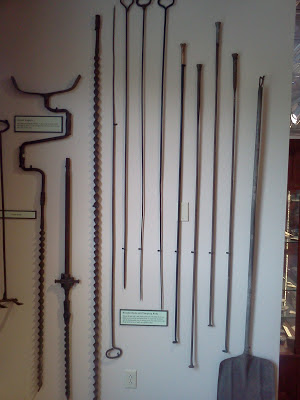Hello there! Just wanted to share some of my travels out to West Virginia, as well as our new tent (to follow). I had some down time in WV, and had the pleasure of visiting an old coal mine, as well as some old mine camp buildings that had been rebuilt on the property. I took a tour of the underground mine as well, but the pics didn't do it justice.

This mine belonged to the Phillips family, and was in operation from 1893 to 1910. It was a family owned business, and when a larger operation started up a mile away, they soon closed up shop. The state bought this chunk of land in the 60's for a recreation area, and shortly discovered the abandoned mine on the property.
The mine had a number of building that had been donated (from local mining camps) to the premises. One of them seen in this photo was the bachelor's shanty (Or for a married man that had come to the mine to work away from home). This is a view of the interior of the extent of his humble abode. Looks like our first studio apartment, only not quite as lavish.
This is from the superintendent's house. An amazing washing machine from the early 20'th century.
The master bath for the common folk.
A bible, found after a major fire. The caption does it justice, as the only pages singed were from the index.
View of the miner's church.
These were the safety lanterns used by the miners. The flame would indicate the level of oxygen in the area, and be a good indicator of methane gas.

Here are two early mining hats. The one on the left was know as a wick lantern, and would burn just about anything you put in it: from oil & kerosene to axle grease & bacon grease. Indestructible, but not very luminescent. The one on the right was a carbide lantern that utilized a chemical reaction to give off its light, and was a vast improvement.
Several lanterns in a display.
Breathing apparatuses. My how times have changed.
Drilling equipment. The earliest drills of course were operated by hand. Once the miner had undercut the seam of coal with his pick, he'd bore a series of holes to plant black powder. Once the powder had been charged and exploded, it would drop down to where the miner had previously cut...thus beginning the laborious process of shoveling the coal into a small cart. The cart in turn would be hauled out by a mule, or a team of goats, or even large dogs (the term 'large' should be understood as 'real' in this instance). This was the late 1800's, and steel wasn't being used in underground mining yet--all of the coal cart tracks were oak timbers.
The earliest skateboard known. Mainly, how the foreman would get around through the mine, along the wooden trusses that the coal carts would traverse. Seen also is a lunch pail.
An early cap, but it couldn't have spoken more truer words.
I'd also like to introduce our new truck tent. It closes off the bed of the truck, when the tailgate is down and the camper shell gate is up.
Built special supports to hold the camper shell gate up, and keep Tango from falling out of the sides...
The intent of this acquisition was to provide not only a bug-free environment, but a raised LEVEL platform that even the dog could be included in. We'll let you know how the trial run goes!















